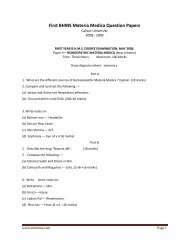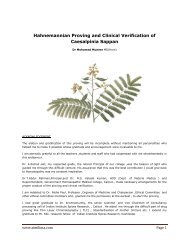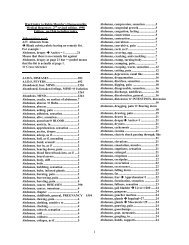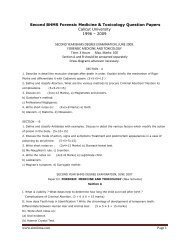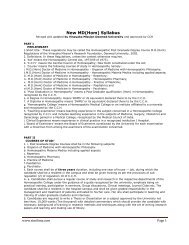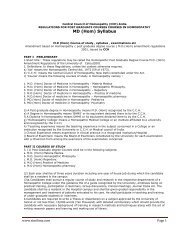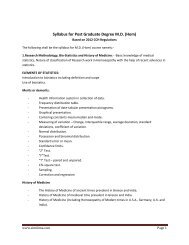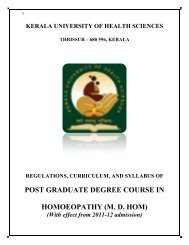Denotations & Old terminologies used in Homopathy - Similima
Denotations & Old terminologies used in Homopathy - Similima
Denotations & Old terminologies used in Homopathy - Similima
You also want an ePaper? Increase the reach of your titles
YUMPU automatically turns print PDFs into web optimized ePapers that Google loves.
complications of kidney or liver disease, or bra<strong>in</strong> <strong>in</strong>juries from trauma or birth<br />
complications. Sometimes, a family history of seizures <strong>in</strong>dicates a hereditary<br />
type of seizures.<br />
Symptoms Return to top<br />
TYPICAL<br />
Muscle activity changes<br />
o No movement<br />
o Hand fumbl<strong>in</strong>g<br />
o Flutter<strong>in</strong>g eyelids<br />
o Lip smack<strong>in</strong>g<br />
o Chew<strong>in</strong>g<br />
Consciousness changes<br />
o Star<strong>in</strong>g episodes (un<strong>in</strong>tentional)<br />
o Lack of awareness of surround<strong>in</strong>gs<br />
o Sudden halt <strong>in</strong> conscious activity (movement, talk<strong>in</strong>g, etc.)<br />
o May be provoked by hyperventilation or flash<strong>in</strong>g lights, <strong>in</strong> some<br />
cases<br />
o Abrupt beg<strong>in</strong>n<strong>in</strong>g of seizure<br />
o Each seizure lasts no more than a few seconds<br />
o Full recovery of consciousness, no confusion<br />
No memory of seizure<br />
ATYPICAL<br />
Atonic seizure<br />
o No muscle movement<br />
o Slump<strong>in</strong>g, loss of posture<br />
o Loss of muscle tone<br />
o Fall<strong>in</strong>g down<br />
Consciousness changes<br />
o Un<strong>in</strong>tentional star<strong>in</strong>g<br />
o Lack of awareness of surround<strong>in</strong>gs<br />
o Sudden stop of conscious activity (movement, talk<strong>in</strong>g, etc.)<br />
o Hand fumbl<strong>in</strong>g<br />
o Flutter<strong>in</strong>g eyelids<br />
o May be provoked by hyperventilation, <strong>in</strong> some cases<br />
o May have slower, gradual beg<strong>in</strong>n<strong>in</strong>g of seizure<br />
o Each lasts only seconds to m<strong>in</strong>utes<br />
o Recovery may be slower<br />
o May have short period of confusion or bizarre behavior<br />
No memory of seizure<br />
Note: Unexpla<strong>in</strong>ed difficulties <strong>in</strong> school and learn<strong>in</strong>g difficulties may be the first<br />
<strong>in</strong>dication of petit mal seizures.<br />
Signs and tests Return to top<br />
The physical exam<strong>in</strong>ation is usually normal, although some neurologic<br />
abnormalities may be present <strong>in</strong> some patients.<br />
Transmission of <strong>in</strong>formation from nerve cell to nerve cell occurs by an<br />
electrochemical process that can be detected as electrical activity by an<br />
electroencephalograph (EEG). A s<strong>in</strong>gle or multiple EEG exams may be necessary<br />
to show changes typical of petit mal seizures. Occasionally, a patient may need<br />
to have EEG monitor<strong>in</strong>g from 1 to several days to detect these EEG changes.<br />
Various laboratory tests, a head CT scan, or a head MRI may be <strong>used</strong> to rule out<br />
specific causes of the seizures.<br />
Phagedenic Spread<strong>in</strong>g, obst<strong>in</strong>ate ulceration.<br />
www.similima.com Page 42



